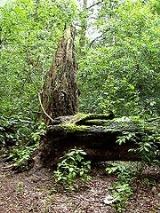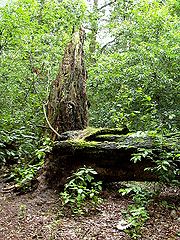
Intermediate Disturbance Hypothesis
Encyclopedia
The Intermediate Disturbance Hypothesis (IDH) states that local species diversity is maximized when ecological disturbance is neither too rare nor too frequent. At low levels of disturbance, more competitive organisms will push subordinate species to extinction and dominate the ecosystem. At high levels of disturbance, due to frequent forest fires or human impacts like deforestation, all species are at risk of going extinct. According to IDH theory, at intermediate levels of disturbance, diversity is thus maximized because both competitive K-selected
and opportunistic r-selected
species can coexist.
This coexistence is a result of the differing life history strategies of species, which dictate a preference for high or low disturbance. K-selected species tend to be more competitive, because they invest a larger proportion of resources into growth and competition and thus generally dominate stable ecosystems over long time periods. In contrast, r-selected species, which colonize open areas quickly, can dominate landscapes recently cleared by disturbance. Therefore, in areas where disturbance occurs occasionally, both species can take advantage of the same region. This effect is observed for the most part in sessile species.
 The notion that disturbance can increase biodiversity opposes the older idea that diversity is highest in undisturbed ecosystem
The notion that disturbance can increase biodiversity opposes the older idea that diversity is highest in undisturbed ecosystem
s. It was first proposed by J. Philip Grime
in 1973. It was then proposed again by Henry S. Horn
in 1975, and then by Joseph Connell in 1978. That Connell's later paper is frequently given priority over Grime's earlier paper has attracted comment in the scientific literature
.
This hypothesis caused concern among the marine science community because of the discrepancy with the 1976 Competition/Predation/Disturbance model proposed by Menge and Sutherland
. In this model, low disturbance influences high predation and high disturbance creates low predation, causing competitive exclusion
to take place. Menge & Sutherland formulated a new model, one that incorporated Connell's ideas in a two part graph published in the American Naturalist (1987). This model proposes that predation
, competition
, and disturbance are all responsible for shaping the diversity of a community under certain circumstances.
Research regarding the effects of intermediate disturbance is ongoing. In one study, dry
and tropical forest
regions were compared to determine how the effects of IDH change due to varying climate.
One alternative proposed in 1985 by Denslow states that the species diversity
in a disturbance-mediated coexistence between species is maximized by the presence of a disturbance regime resembling the historic processes. This is because species generally adapt to the level of disturbance in their ecosystem through evolution (whether disturbance is of high, intermediate or low level). Many species (e.g. ruderal plants, fire-adapted species) even depend on disturbance in ecosystems where it often occurs.
However, the IDH theory has gained traction in the field of ecology and remains a useful framework for understanding the influence of disturbance on biodiversity within communities. Due to the complicated interactions of ecosystems, the IDH, like all theories, represents a simplification of competition interactions. Thus, some have come to understand the theory as a series of similar phenomena dictated by the unique aspects of each community.
R/K selection theory
In ecology, r/K selection theory relates to the selection of combinations of traits in an organism that trade off between quantity or quality of offspring...
and opportunistic r-selected
R/K selection theory
In ecology, r/K selection theory relates to the selection of combinations of traits in an organism that trade off between quantity or quality of offspring...
species can coexist.
This coexistence is a result of the differing life history strategies of species, which dictate a preference for high or low disturbance. K-selected species tend to be more competitive, because they invest a larger proportion of resources into growth and competition and thus generally dominate stable ecosystems over long time periods. In contrast, r-selected species, which colonize open areas quickly, can dominate landscapes recently cleared by disturbance. Therefore, in areas where disturbance occurs occasionally, both species can take advantage of the same region. This effect is observed for the most part in sessile species.
History

Ecosystem
An ecosystem is a biological environment consisting of all the organisms living in a particular area, as well as all the nonliving , physical components of the environment with which the organisms interact, such as air, soil, water and sunlight....
s. It was first proposed by J. Philip Grime
J. Philip Grime
John Philip Grime is a prominent British ecologist and emeritus professor at the University of Sheffield. He is best known for his CSR theory on plant strategies, for the unimodal relationship between species richness and site productivity , for the Intermediate Disturbance Hypothesis, for the DST...
in 1973. It was then proposed again by Henry S. Horn
Henry S. Horn
Henry S. Horn is a natural historian and ecologist. He is currently an emeritus professor in the Ecology and Evolutionary Biology Department at Princeton University...
in 1975, and then by Joseph Connell in 1978. That Connell's later paper is frequently given priority over Grime's earlier paper has attracted comment in the scientific literature
Scientific literature
Scientific literature comprises scientific publications that report original empirical and theoretical work in the natural and social sciences, and within a scientific field is often abbreviated as the literature. Academic publishing is the process of placing the results of one's research into the...
.
This hypothesis caused concern among the marine science community because of the discrepancy with the 1976 Competition/Predation/Disturbance model proposed by Menge and Sutherland
Charles Sutherland Elton
Charles Sutherland Elton FRS was an English zoologist and animal ecologist. His name is associated with the establishment of modern population and community ecology, including studies of invasive organisms.-Personal life:...
. In this model, low disturbance influences high predation and high disturbance creates low predation, causing competitive exclusion
Competitive exclusion principle
In ecology, the competitive exclusion principle, sometimes referred to as Gause's law of competitive exclusion or just Gause's law, is a proposition which states that two species competing for the same resources cannot coexist if other ecological factors are constant...
to take place. Menge & Sutherland formulated a new model, one that incorporated Connell's ideas in a two part graph published in the American Naturalist (1987). This model proposes that predation
Predation
In ecology, predation describes a biological interaction where a predator feeds on its prey . Predators may or may not kill their prey prior to feeding on them, but the act of predation always results in the death of its prey and the eventual absorption of the prey's tissue through consumption...
, competition
Competition
Competition is a contest between individuals, groups, animals, etc. for territory, a niche, or a location of resources. It arises whenever two and only two strive for a goal which cannot be shared. Competition occurs naturally between living organisms which co-exist in the same environment. For...
, and disturbance are all responsible for shaping the diversity of a community under certain circumstances.
Research regarding the effects of intermediate disturbance is ongoing. In one study, dry
Tropical and subtropical dry broadleaf forests
The tropical and subtropical dry broadleaf forest biome, also known as tropical dry forest, is located at tropical and subtropical latitudes. Though these forests occur in climates that are warm year-round, and may receive several hundred centimeters of rain per year, they have long dry seasons...
and tropical forest
Tropical and subtropical moist broadleaf forests
Tropical and subtropical moist broadleaf forests , also known as tropical moist forests, are a tropical and subtropical forest biome....
regions were compared to determine how the effects of IDH change due to varying climate.
Support and Critiques
Debate over the validity of the IDH is ongoing as the theory is tested in various ecological communities. Other evidence exists for and against the hypothesis.One alternative proposed in 1985 by Denslow states that the species diversity
Species diversity
Species diversity is an index that incorporates the number of species in an area and also their relative abundance. It is a more comprehensive value than species richness....
in a disturbance-mediated coexistence between species is maximized by the presence of a disturbance regime resembling the historic processes. This is because species generally adapt to the level of disturbance in their ecosystem through evolution (whether disturbance is of high, intermediate or low level). Many species (e.g. ruderal plants, fire-adapted species) even depend on disturbance in ecosystems where it often occurs.
However, the IDH theory has gained traction in the field of ecology and remains a useful framework for understanding the influence of disturbance on biodiversity within communities. Due to the complicated interactions of ecosystems, the IDH, like all theories, represents a simplification of competition interactions. Thus, some have come to understand the theory as a series of similar phenomena dictated by the unique aspects of each community.

